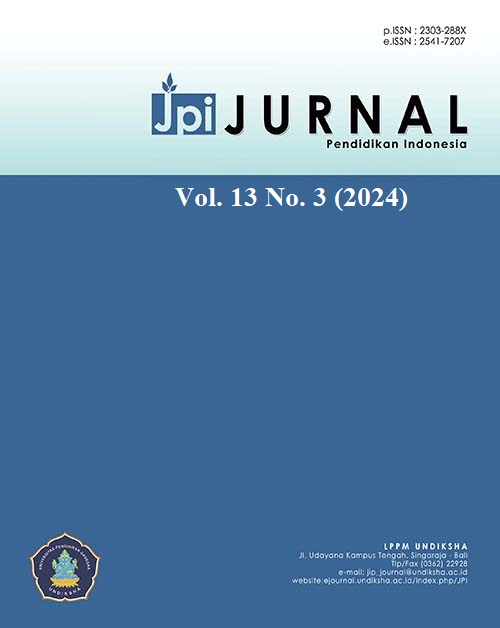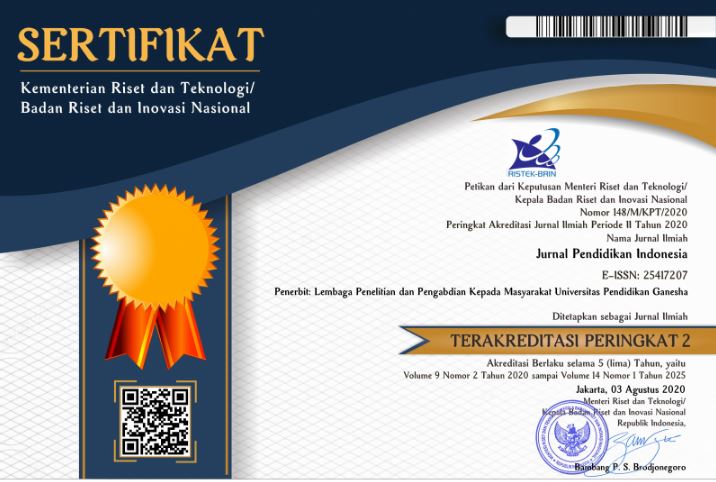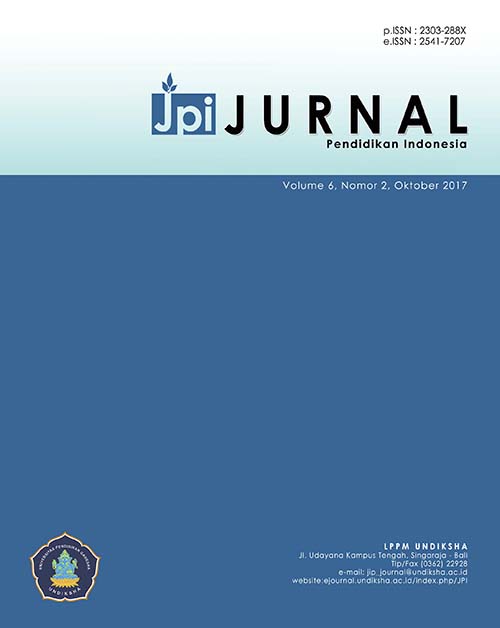STEM-Based Animation Learning Videos to Improve Critical Thinking Skills and Self-Directed Learning
DOI:
https://doi.org/10.23887/jpiundiksha.v13i3.74226Keywords:
Animation Learning Videos, Science, STEM, Learning Styles, Critical Thinking, Independent LearningAbstract
This research is motivated by the low critical thinking ability and learning independence of elementary school students. This research aims to develop STEM-based animation learning videos that are feasible, practical, and effective in improving these two aspects. The research uses a research and development (R&D) method with a 4D development model consisting of the stages of define, design, develop, and disseminate according to the Thiagarajan model. The subject of this study involves elementary school students as the main users. Data collection is carried out through feasibility tests, practicality, and effectiveness by involving material experts, media experts, teachers, and students. Data analysis uses independent t test and MANOVA for effectiveness. The results of the study showed that the learning videos developed were considered feasible by material experts (91.7) and media experts (80). The effectiveness of the product can be seen from the results of the independent t test and MANOVA with a significance of 0.000. The practicality of the video was rated high by teachers (88) and students (92.8), with a 100% implementation rate. The conclusion of this study is that STEM-based animation learning videos are able to significantly improve the critical thinking ability and learning independence of elementary school students, so that it can be implicated in learning.
References
Abidin, N. L. F., Dwiningsih, K., Jehwae, P., & Sari, C. K. (2024). Leveraging technology to improve learning independence in chemistry: A study on Moodle integration. Indonesian Journal on Learning and Advanced Education (IJOLAE), 6(3), 365–386. https://doi.org/10.23917/ijolae.v6i3.23706.
Abu Khurma, O., Al Darayseh, A., & Alramamneh, Y. (2022). A Framework for Incorporating the “Learning How to Learn” Approach in Teaching STEM Education. Education Sciences, 13(1), 1–19. https://doi.org/10.3390/educsci13010001.
Albay, E. M. (2019). Analyzing the effects of the problem solving approach to the performance and attitude of first year university students. Social Sciences & Humanities Open, 1(1), 100006. https://doi.org/10.1016/j.ssaho.2019.100006.
Anshar, M. A., Rahayu, Y. S., Erman, E., Karimah, K., & Rofiq, A. (2023). The Analysis of Umar Masud Junior High School Students Science Literacy Ability. Jurnal Penelitian Pendidikan IPA, 9(2), 926–930. https://doi.org/10.29303/jppipa.v9i2.2667.
Argianti, A., & Andayani, S. (2021). Keefektifan pendekatan STEM berbantuan Wolfram Alpha pada pembelajaran matematika ditinjau dari motivasi dan kemandirian belajar. Jurnal Riset Pendidikan Matematika, 8(2), 217–230. https://doi.org/10.21831/jrpm.v8i2.35263.
Assagaf, G. (2016). Pengaruh kemandirian belajar dan regulasi diri terhadap hasil belajar matematika melalui motivasi berprestasi pada siswa kelas X SMA Negeri di Kota Ambon. Matematika Dan Pembelajaran, 4(1), 23–32. https://doi.org/10.33477/mp.v4i1.306.
Basri, H., & As’ ari, A. R. (2019). Investigating critical thinking skill of junior high school in solving mathematical problem. International Journal of Instruction, 12(3), 745–758. https://doi.org/10.29333/iji.2019.12345a.
Belt, E. S., & Lowenthal, P. R. (2021). Video use in online and blended courses: a qualitative synthesis. Distance Education, 42(3), 410–440. https://doi.org/10.1080/01587919.2021.1954882.
Bradshaw, Z., & Hazell, A. (2017). Developing problem-solving skills in mathematics: a lesson study. International Journal for Lesson and Learning Studies, 6(1), 32–44. https://doi.org/10.1108/IJLLS-09-2016-0032.
Brame, C. J. (2016). Effective Educational Videos: Principles and Guidelines for Maximizing Student Learning from Video Content. CBE—Life Sciences Education, 15(4). https://doi.org/10.1187/cbe.16-03-0125.
Çiftçi, A., Topçu, M. S., & Foulk, J. A. (2022). Pre-service early childhood teachers’ views on STEM education and their STEM teaching practices. Research in Science & Technological Education, 40(2), 207–233. https://doi.org/10.1080/02635143.2020.1784125.
Dumitru, D. (2019). Creating meaning. The importance of Arts, Humanities and Culture for critical thinking development. Studies in Higher Education, 44(5), 870–879. https://doi.org/10.1080/03075079.2019.1586345.
Fyfield, M., Henderson, M., Heinrich, E., & Redmond, P. (2019). Videos in higher education: Making the most of a good thing. Australasian Journal of Educational Technology, 35(5), 1–7. https://doi.org/10.14742/ajet.5930.
Gencer, A. S., & Doğan, H. (2020). The Assessment of the Fifth-Grade Students’ Science Critical Thinking Skills through Design-Based STEM Education. International Journal of Assessment Tools in Education, 7(4), 690–714. https://doi.org/10.21449/ijate.744640.
Gusteti, M. U., Wulandari, S., Rahmalina, W., Putri, M., & Putri, E. K. (2023). Development of Electronic Handouts Using Numerical Literacy-Based Mathemagics Methods for Learning in the Digital Era. Jurnal Eksakta Pendidikan (JEP), 7(1), 115–125. https://doi.org/10.24036/jep/vol7-iss1/709.
Hacioglu, Y., & Gulhan, F. (2021). The Effects of STEM Education on the 7th Grade Students’ Critical Thinking Skills and STEM Perceptions. Journal of Education in Science, Environment and Health, 7(2), 139–155. https://doi.org/10.21891/jeseh.771331.
Hamidi, H., & Chavoshi, A. (2018). Analysis of the essential factors for the adoption of mobile learning in higher education: A case study of students of the University of Technology. Telematics and Informatics, 35(4), 1053–1070. https://doi.org/10.1016/j.tele.2017.09.016.
Haryandi, S., Misbah, M., Mastuang, M., Dewantara, D., & Mahtari, S. (2019). Analysis of students’ critical thinking skills on solid material elasticity. Kasuari: Physics Education Journal (KPEJ), 2(2), 89–94. https://doi.org/10.37891/kpej.v2i2.95.
Heitink, M., Voogt, J., Verplanken, L., van Braak, J., & Fisser, P. (2016). Teachers’ professional reasoning about their pedagogical use of technology. Computers & Education, 101, 70–83. https://doi.org/10.1016/j.compedu.2016.05.009.
Hughes, J. E., Cheah, Y. H., Shi, Y., & Hsiao, K. H. (2020). Preservice and inservice teachers’ pedagogical reasoning underlying their most-valued technology-supported instructional activities. Journal of Computer Assisted Learning, 36(4), 549–568. https://doi.org/10.1111/jcal.12425.
Johnson, C. C., Moore, T. J., & Peters-Burton, E. E. (2021). STEM Road Map 2.0: A Framework for Integrated STEM Education in the Innovation Age. Routledge. https://doi.org/10.4324/9781003034902.
Kania, N., Fitriani, C., & Bonyah, E. (2023). Analysis of Students’ Critical Thinking Skills Based on Prior Knowledge Mathematics. International Journal of Contemporary Studies in Education (IJ-CSE), 2(1), 49–58. https://doi.org/10.56855/ijcse.v2i1.248.
Kelley, T. R., & Knowles, J. G. (2016). A conceptual framework for integrated STEM education. International Journal of STEM Education, 3, 1–11. https://doi.org/10.1186/s40594-016-0046-z.
Kuhn, D. (2019). Critical Thinking as Discourse. Human Development, 62(3), 146–164. https://doi.org/10.1159/000500171.
Mellisa, M., & Yanda, Y. D. (2019). Developing audio-visual learning media based on video documentary on tissue culture explant of Dendrobium bigibbum. JPBI (Jurnal Pendidikan Biologi Indonesia), 5(3), 379–386. https://doi.org/10.22219/jpbi.v5i3.9993.
Morris, T. H. (2019). Self-directed learning: A fundamental competence in a rapidly changing world. International Review of Education, 65(4), 633–653. https://doi.org/10.1007/s11159-019-09793-2.
Murniati, C. T., Hartono, H., & Cahyo Nugroho, A. (2023). The challenges, supports, and strategies of self-directed learning among college students. Journal of Education and Learning (EduLearn), 17(3), 365–373. https://doi.org/10.11591/edulearn.v17i3.20744.
Nasution, T., Afrianti, D., Tukiyo, T., Sulistyani, S., & Herman, H. (2022). Critical Discourse Analysis in the Classroom: A Critical Language Awareness on Early Children’s Critical Thinking. Jurnal Obsesi: Jurnal Pendidikan Anak Usia Dini, 6(5), 4992–5002. https://doi.org/10.31004/obsesi.v6i5.2951.
Ningsih, R., & Nurrahmah, A. (2016). Pengaruh Kemandirian Belajar dan Perhatian Orang Tua Terhadap Prestasi Belajar Matematika. Formatif: Jurnal Ilmiah Pendidikan MIPA, 6(1), 73–84. https://doi.org/10.30998/formatif.v6i1.754.
Nurhayati, Y., Sopandi, W., & Riandi, R. (2023). Scientific Literacy Profile of Pre-Service Elementary School Teacher Students. Jurnal Penelitian Pendidikan IPA, 9(7), 5474–5480. https://doi.org/10.29303/jppipa.v9i7.3510.
Nurilma, F. R., Supriana, E., & Diantoro, M. (2023). Using STEM-Based 3D-Multimedia to Improve Students’ Critical Thinking Skills in Uniform Circular Motion. Jurnal Pendidikan Fisika, 11(2), 193–201. https://doi.org/10.26618/jpf.v11i2.10785.
Ortiz-Revilla, J., Adúriz-Bravo, A., & Greca, I. M. (2020). A framework for epistemological discussion on integrated STEM education. Science & Education, 29(4), 857–880. https://doi.org/10.1007/s11191-020-00131-9.
Ortiz-Revilla, J., Greca, I. M., & Arriassecq, I. (2022). A Theoretical Framework for Integrated STEM Education. Science & Education, 31(2), 383–404. https://doi.org/10.1007/s11191-021-00242-x.
Putri, D. P., Ferdianto, F., & Fauji, S. H. (2020). Designing a Digital Teaching Module Based on Mathematical Communication in Relation and Function. Journal on Mathematics Education, 11(2), 223–236. https://doi.org/10.22342/jme.11.2.7320.223-236.
Rahayu, E. Y., Nurani, Y., & Meilanie, S. M. (2023). Pembelajaran yang terinspirasi STEAM: Menumbuhkan Keterampilan Berpikir Kritis melalui Video Tutorial. Jurnal Obsesi : Jurnal Pendidikan Anak Usia Dini, 7(3), 2627–2640. https://doi.org/10.31004/obsesi.v7i3.4228.
Sablić, M., Mirosavljević, A., & Škugor, A. (2021). Video-Based Learning (VBL)—Past, Present and Future: an Overview of the Research Published from 2008 to 2019. Technology, Knowledge and Learning, 26(4), 1061–1077. https://doi.org/10.1007/s10758-020-09455-5.
Sellars, M., Fakirmohammad, R., Bui, L., Fishetti, J., Niyozov, S., Reynolds, R., & Ali, N. (2018). Conversations on Critical Thinking: Can Critical Thinking Find Its Way Forward as the Skill Set and Mindset of the Century? Education Sciences, 8(4), 205. https://doi.org/10.3390/educsci8040205.
Siagian, T. A., Armanto, D., & Siagian, P. (2021). Development of learning device oriented problem based learning to improve student’s mathematical problem solving skill. Journal of Physics: Conference Series, 1731(1). https://doi.org/10.1088/1742-6596/1731/1/012056.
Sochacka, N. W., Guyotte, K. W., & Walther, J. (2016). Learning together: A collaborative autoethnographic exploration of STEAM (STEM+ the Arts) education. Journal of Engineering Education, 105(1), 15–42. https://doi.org/10.1002/jee.20112.
Suheryani, Y., Indriani, S., & Murni, S. (2018). Improved Learning Outcomes In Calculating Reduction Operations Using Concrete Object Media. COLLASE (Creative of Learning Students Elementary Education), 1(3), 138–145. https://doi.org/10.22460/collase.v1i3.2279.
Takeuchi, M. A., Sengupta, P., Shanahan, M. C., Adams, J. D., & Hachem, M. (2020). Transdisciplinarity in STEM education: a critical review. Studies in Science Education, 56(2), 213–253. https://doi.org/10.1080/03057267.2020.1755802.
Tegeh, I. M., Parwata, I. G. L. A., & Ostaviani, B. G. (2020). The Observing Learning Activity Assisted by Concrete Media Improves Student’s Conceptual Knowledge. JPI (Jurnal Pendidikan Indonesia), 9(2), 182–192. https://doi.org/10.23887/jpi-undiksha.v9i2.25206.
Ültay, N., & Ültay, E. (2020). A Comparative Investigation of the Views of Preschool Teachers and Teacher Candidates about STEM. Journal of Science Learning, 3(2), 67–78. https://doi.org/10.17509/jsl.v3i2.20796.
Ulva, S. M. (2017). Developing PBL kit by utilizing blog in order to improve scientific process and problem solving skills in physics learning. Jurnal Inovasi Pendidikan IPA, 3(1), 89–100. https://doi.org/10.21831/jipi.v3i1.13678.
Usuf, M. M., Amin, M., & Nugrahaningsih, N. (2017). Developing of instructional media-based animation video on enzyme and metabolism material in senior high school. JPBI (Jurnal Pendidikan Biologi Indonesia), 3(3), 254–257. https://doi.org/10.22219/jpbi.v3i3.4744.
Voskamp, A., Kuiper, E., & Volman, M. (2022). Teaching practices for self-directed and self-regulated learning: case studies in Dutch innovative secondary schools. Educational Studies, 48(6), 772–789. https://doi.org/10.1080/03055698.2020.1814699.
Winarti, W., Sulisworo, D., & Kaliappen, N. (2021). Evaluation of STEM-Based Physics Learning on Students’ Critical Thinking Skills: A Systematic Literature Review. Indonesian Review of Physics, 4(2), 61–69. https://doi.org/10.12928/irip.v4i2.3814.
Wu, S. P., & Rau, M. A. (2019). How students learn content in science, technology, engineering, and mathematics (STEM) through drawing activities. Educational Psychology Review, 31, 87–120. https://doi.org/10.1007/s10648-019-09467-3.
Yoon, S., Kim, S., & Kang, M. (2020). Predictive power of grit, professor support for autonomy and learning engagement on perceived achievement within the context of a flipped classroom. Active Learning in Higher Education, 21(3), 233–247. https://doi.org/10.1177/1469787418762463.
Zainuddin, Z., & Perera, C. J. (2019). Exploring students’ competence, autonomy and relatedness in the flipped classroom pedagogical model. Journal of Further and Higher Education, 43(1), 115–126. https://doi.org/10.1080/0309877X.2017.1356916.
Zulhelmi, Z., Fauza, N., Syaflita, D., Pratiwi, J., Wijaya, T. T., & Hermita, N. (2023). Development of Learning Media to Improve Students’ Higher Order Thinking Skills in Circular Motion Material. Jurnal Penelitian Pendidikan IPA, 9(4), 1734–1740. https://doi.org/10.29303/jppipa.v9i4.3536.
Downloads
Published
Issue
Section
License
Copyright (c) 2024 Siti Wulandari Mamonto, Zuhdan Kun Prasetyo, Ujang Sugara, Susan N. H. Jacobus

This work is licensed under a Creative Commons Attribution-ShareAlike 4.0 International License.
Authors who publish with the Jurnal Pendidikan Indnesia agree to the following terms:
- Authors retain copyright and grant the journal the right of first publication with the work simultaneously licensed under a Creative Commons Attribution License (CC BY-SA 4.0) that allows others to share the work with an acknowledgment of the work's authorship and initial publication in this journal.
- Authors are able to enter into separate, additional contractual arrangements for the non-exclusive distribution of the journal's published version of the work (e.g., post it to an institutional repository or publish it in a book), with an acknowledgment of its initial publication in this journal.
- Authors are permitted and encouraged to post their work online (e.g., in institutional repositories or on their website) prior to and during the submission process, as it can lead to productive exchanges, as well as earlier and greater citation of published work. (See The Effect of Open Access)








